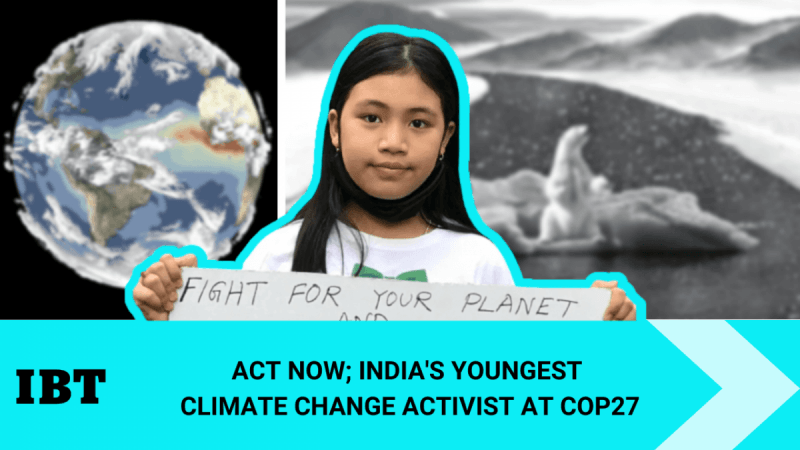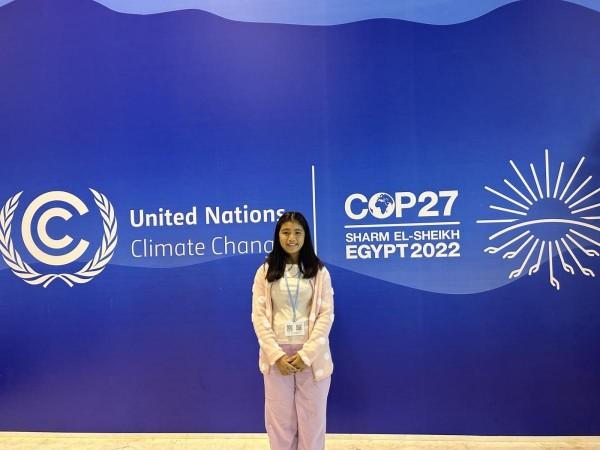The 27th session of the Conference of Parties (COP27) to the UN Framework Convention on Climate Change has kicked off in Egypt's coastal city of Sharm El-Sheikh, introducing for the first time the loss and damage funding into the agenda.
The term "loss and damage" in UN climate negotiations refers to expenses already incurred as a result of climate change impacts, such as rising sea levels or extreme heat waves. While current climate funding focuses on cutting carbon emissions to prevent climate change in the future, establishing a "loss and damage" fund means compensating countries that can't avoid or "adapt" to the changes that have already happened.
Attending the conference is also the noted Indian climate and environmental activist - Licypriya Kangujam, who arrived in Sharm El-Sheikh for the UN COP27 Climate Change Summit. The 11-year-old girl, with her vocal views on climate change, has demanded strict laws to fight climate change.

Who is Licypriya Kangujam (Licy)?
Licy is a familiar name in the circles of climate change activists. She is one of the youngest climate activists globally, who has been championing her cause to protect, preserve and nurture our environment by fighting climate change at an even tender age of just six. Not just in India, she has traveled the world for her cause, bringing to notice the alarming effects of climate change in front of world leaders.
Transforming the Taj Mahal into a plastic pollution-free monument in June 2022 is to her credit. She has even attended the United Nations Climate Conference 2019 (COP25) in Madrid and the 77th Session of the United Nations General Assembly 2022. She has spoken in over 400 institutions and other platforms in over 32 countries advocating to adults about the threat of climate change as a part of her movement.
So how did this inspiring journey of India's youngest climate activist begin?
Licy was born in Manipur, a state in Northeast India known for being carbon negative. She grew up in Bhubaneswar before moving to Delhi in 2019. But the life-changing moment was when the devastating Cyclone Titli hit in 2018 Cyclone Fani in 2019.

"During the cyclones, many people lost their lives and many children lost their parents and thousands of people become homeless. I was very sad. I couldn't sleep, I couldn't drink. I even couldn't take my food," Licy recalls.
And when she moved to Delhi, she was shocked by the high air pollution and extreme heat wave crisis. Licy decided to take things into her hands and hoped to bring about a change, which would be for the future of this world. She was just six at the time. She is also the founder of The Child Movement foundation and Special Envoy to the President of Timor Leste.
What is Licy fighting for?
Speaking to International Business Times, Licy revealed she has three main demands from the leaders of the world to fight climate change.
To pass a climate change law as soon as possible in the parliament: If they pass a climate change law then it will help to control the carbon emissions and greenhouse gases. It will also give climate. justice to millions of poor vulnerable people who are already the victim of climate change.
To make climate education mandatory in the school education curriculum: If they include climate change as compulsory in our school education curriculum then we can fight the climate change from the grassroots. There will be no climate solution without climate education.
To plant minimum 10 trees every year by each student: In India, there are 350 million students. If 350 million students plant minimum 10 trees every year, we will plant 3.5 billion trees every year. Trust me, India will be green in 5-10 years.
For a young girl her age, she has a dream of a visionary. She hopes to see more bicycle on roads instead of more fossil fuel vehicles; coal power plants and thermal power plants replaced by clean energy; clean air to breathe; clean water to drink and a clean planet to live in.
"Asking clean air to breathe, clean water to drink and clean planet to live is our basic rights."
Licy is making all the efforts possible to make her demands heard loud and clear. For instance, just to get to COP27 in Egypt, she sold tea on the streets and raised the funds. She calls upon world leaders to drive change and deliver climate justice. "Your action today will decide our future tomorrow," she says.
From tomorrow, I will begin my campaign at the #COP27 by speaking at @CTVNews Canada ?? & @BBC News, UK ?? to urge our world leaders to take concrete climate action on #LossAndDamage to save our future.@COP27P is our last hope. For us, #COP27 will decide life or death! ? pic.twitter.com/HN5iKDRdzA
— Licypriya Kangujam (@LicypriyaK) November 6, 2022

Licy is also taking her cause to her school, where she says her friends join her in the efforts to fight climate change. Inspired by her, many students stopped using single-use plastic and join Licy in her cleanliness drives, climate protests, and massive tree plantations.
Licy's commitment to climate change isn't taking her focus away from her studies. She makes sure her studies and activism is balanced out without affecting one or the other. She reserves program invitations for weekends and other holidays and interviews and other activities until after school hours in the afternoon. Like many kids her age, she also plays with her friends every day in the evening.
India at COP27
Environment Minister Bhupender Yadav on Sunday inaugurated India Pavilion at the conference, scheduled from November 6 till 18. While inaugurating the pavilion, Yadav said: "India believes climate action starts from the grassroots, individual level and hence designed the India Pavilion with the theme of LiFE- Lifestyle for Environment."
India also pushed forward the idea of climate finance, introduction of new technologies, and new collaborations to facilitate technology transfers, he added.
Licy acknowledges India's efforts in its fight against climate change. But raises the bigger question of what the developed nations are doing on this front.
"Rich countries must pay for the loss and damage, I mean urgent climate finance, not as a loan to the developing countries to achieve the Paris Climate Agreement. Otherwise, it will be impossible to keep 1.5 degree Celsius alive," she said.
India ?? is doing the best to solve the global climate crisis. Are rich countries doing enough?
— Licypriya Kangujam (@LicypriyaK) November 8, 2022
India can't pay the price of the climate sins of the west!#COP27 pic.twitter.com/G2oIUZ2Mdl














